
The clouded border is a moth of the family Geometridae. The species was first described by Carl Linnaeus in his 1758 10th edition of Systema Naturae. It is distributed across most of Europe to the Urals, western and central Siberia, Transbaikalia, Kazakhstan, Tian-Shan, northern Mongolia and parts of the Near East.

The mottled umber is a moth of the family Geometridae. It is common throughout much of the Palearctic region. The species was first described by Carl Alexander Clerck in 1759.

Apatura iris, the purple emperor, is a Palearctic butterfly of the family Nymphalidae.

Furcula furcula, the sallow kitten, is a moth from the family Notodontidae. It was first described by the Swedish entomologist Carl Alexander Clerck in 1759 from a specimen found in Sweden.

Plagodis pulveraria, the barred umber, is a moth of the family Geometridae. The species was first described by Carl Linnaeus in his 1758 10th edition of Systema Naturae. It is found throughout much of the Palearctic realm from Ireland to Japan, and in the Nearctic realm (Canada).
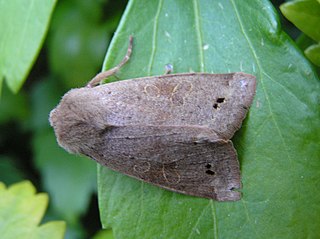
Perigrapha munda, the twin-spotted Quaker, is a species of moth of the family Noctuidae. The wings are gray, with two closely approximate and very conspicuous dark spots on the disc of the fore wings. a small dark apical mark at the costal edge and a discal spot on the fuscous hindwings. It is found in Palearctic realm.

Xanthia togata, the pink-barred sallow, is a species of moth of the family Noctuidae. It is a Holarctic species, and is found throughout Europe and east through the Palearctic to Central Asia, and Siberia up to the Ussuri. The distribution area includes the United States and Canada. It was first described by the German entomologist Eugenius Johann Christoph Esper in 1788 from the type specimen in Germany

Copivaleria is a monotypic moth genus of the family Noctuidae erected by Augustus Radcliffe Grote in 1883. Its only species, Copivaleria grotei, or Grote's sallow, was first described by Herbert Knowles Morrison in 1874. It is found in eastern North America, including Ontario, Tennessee, New York and Maryland.

Agrochola bicolorago, the bicolored sallow or shield-backed cutworm, is a moth in the family Noctuidae. The species was first described by Achille Guenée in 1852. It is found in the eastern half of the United States and Canada.
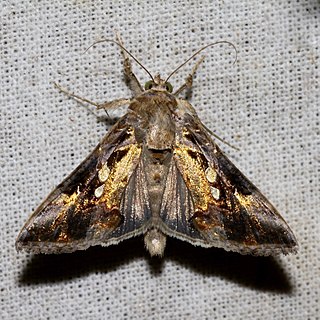
Argyrogramma signata, the green semilooper, is a moth of the family Noctuidae.

Pyrrhia cilisca is a moth of the family Noctuidae first described by Achille Guenée in 1852. Pyrrhia adela was placed as a synonym of Pyrrhia cilisca. Pyrrhia adela was introduced as the new scientific name for the North American population of moths which was formerly considered to be Pyrrhia umbra, hence both species have the common name bordered sallow, although adela was also referred to as the American bordered sallow. It is found in North America from Newfoundland west to Manitoba, South Carolina west to Texas.

Psaphida rolandi, or Roland's sallow, is a moth of the family Noctuidae. The species was first described by Augustus Radcliffe Grote in 1874. It is found in North America from southern Ontario and Quebec, south to Florida.

Eucalyptus signata is a species of evergreen tree native to eastern Australia. It is one of many trees known as the Scribbly Gum. The habitat is dry sclerophyll forests or swampy areas at low altitude. Occurring from Morisset, New South Wales up the coast and ranges to beyond the Queensland border. The original specimen was collected at the Brisbane River.

" Pulchrana signata, commonly known as the variable-backed frog, striped stream frog, spotted stream frog, or Matang frog, is a species of "true frog". It is native to the Malay Peninsula, Sumatra and Natuna Archipelago (Indonesia), and Borneo. Its occurs in lowland tropical forests, including swamp and heath forests, a altitudes up to 700 m (2,300 ft) above sea level. It is not currently considered threatened by the IUCN.
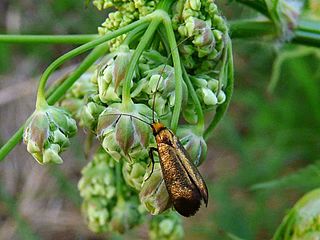
Adela cuprella is a moth of the family Adelidae and are found in most of Europe. It was first described by Michael Denis & Ignaz Schiffermüller in 1775 and the type locality is from Austria. They can be found flying around sallows (Salix) species during the day in April and May.
Synanthedon flaviventris, the sallow clearwing, is a moth of the family Sesiidae. The larvae form pear-shaped galls on sallows.
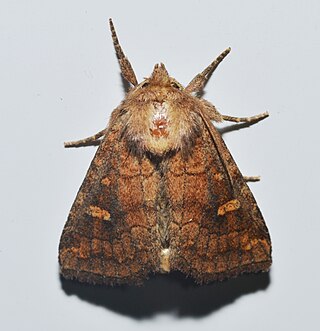
Tricholita signata, the signate Quaker, is a moth in the family Noctuidae described by Francis Walker in 1860. It is found in North America.
Pericoma signata is a species of moth fly in the family Psychodidae.
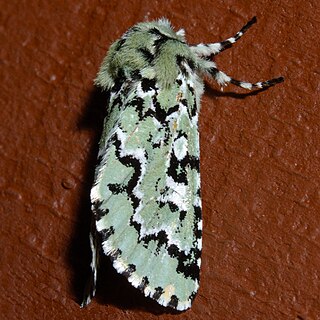
Feralia deceptiva, the deceptive sallow, is a species of mossy sallow in the moth family Noctuidae. It is found in North America.


















